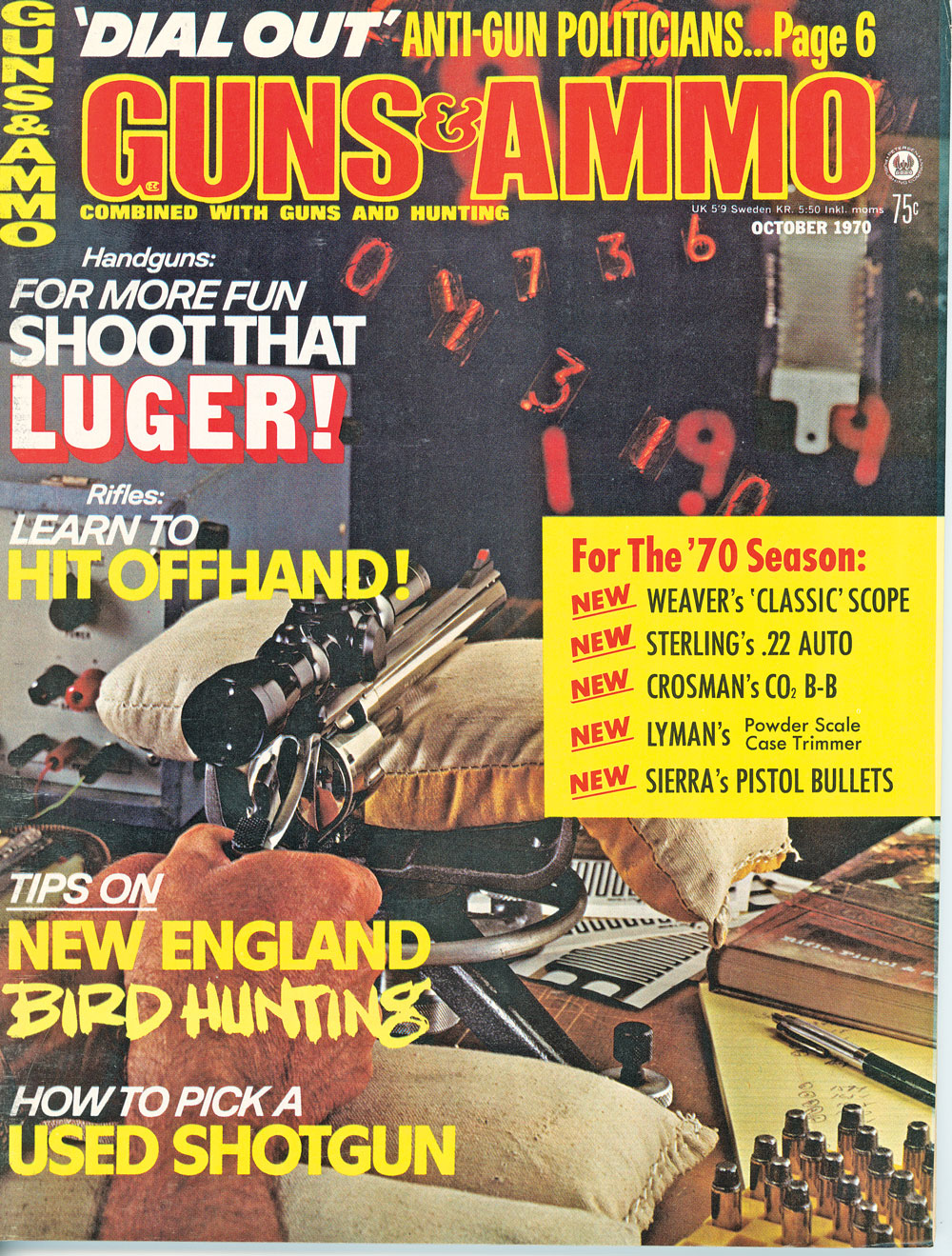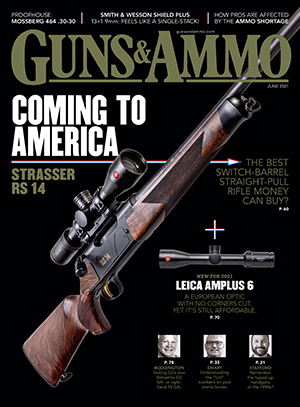How To Measure Bullet Speed

June 07, 2018
William L. Casteel authored "How fast do she go? and How do you know?" in the October 1970 issue of Guns & Ammo. Casteel summarized the development of various devices that measured velocity and noted the challenges faced by mathematicians to create formulas through calculus that translated measurements to comparable information. The original story is beneath.
Almost anyone who is interested in finding the velocity of a bullet today tin can do so without much bother. We have cheap and relatively accurate chronographs available, while the professional ballistics laboratories with their sophisticated equipment can make measurements of farthermost accurateness. But did yous always wonder most the fourth dimension before the transistor and the oscilloscope? Just how did the blackpowder burners determine which Minie ball left the muzzle fastest? Well, men take been making velocity measurements for a long fourth dimension, and surprisingly accurate ones too.
Before the full general use of mechanical gadgets, mathematicians were using calculus to notice the muzzle velocity of cannons. About 1738 a Swiss named Bernoulli would burn down a cannon vertically and count the 2d required for the brawl to strike the ground. Then past mathematics, make up one's mind the muzzle velocity. I often wonder just where he stood while waiting for that brawl to come up down. The first practical device was the Ballistic Pendulum, which was invented by an Englishman, Benjaman Robins. This was a heavy pendulum into which the bullet was fired and which retained the bullet. The velocity could be determined by a formula because the velocity of the bullet was given to the pendulum, and the pendulum swing could be accurately measured. These pendulums have been modified and improved over the years. When properly used, they are surprisingly accurate.
However men persisted in trying to meacertain more precisely the time of bullet flying by gauging it over a brusque distance. The earliest record of an actual mechanical chronograph that I have been able to locate, is that of ane invented in 1773 by an experimenter named Mathey. He used loftier-speed clockworks to rotate a vertical cylinder of paper-thin. The bullet was and so fired through the drum, directly beyond the axis. Of course with the drum rotating, the entrance pigsty had moved off the line of fire by the time the bullet cut its exit hole. By measuring how far off the axis the holes were, he could calculate how long the bullet had been inside the drum. His accuracy was non good considering at that time there was no really efficient way to determine the speed of rotation. But the idea was audio and the basis for many afterwards devices such as Grobert's velocity was determined past measuring the bending of deportation between the ii holes. This machine also went through many improvements and finally, using electric motors to drive the discs and tachometers to adjust the R.P.M., were authentic to nearly 0.7 percent when used with rifles of 2500 fps or so.
Some devices were fabricated which utilized the bullet's cutting of a cord to kickoff a timing sequence. One of these was the Benton Thread Yelocimeter. The big problem hither was that, although cutting the first thread was easy, it was a piddling tough to hitting the second one with whatever degree of certainty. Benton solved this past letting the bullet strike a steel plate which in turn cut the second thread. He used a novel device to meacertain the interval. Two pocket-size pendulums were suspended from a common beam, but held horizontally opposite, 180 degrees autonomously. When the first string was out, it released one pendulum. The second string released the other. When the two passed they struck a glancing blow which marked a calibrated semicircle of newspaper.
Probably the most significant development in ball is tics measurements since Robin's pendulum was when the famous physicist Wheatstone used the breaking of ii wires by the bullet to control an electric current. This was in 1840, and the first Wheatstone ballistic chronograph used the breaking of the get-go wire to starting time a leap wound clock and the second turned it off. The accurateness was only fair, but the principle opened the way for an entire generation of chronographs, and of course is nonetheless used today on most of our electronic types.
A lot of early on chronographs utilized the current to control electromagnets. Ane of the commencement of these was the Navez pendulum of 1854, invented in French republic. The pendulum was held in a horizontal position past an electromagnet. When the first wire was cutting, the current was close off to this magnet and the pendulum started to swing down. When the 2nd wire was cut, some other magnet was energized and the pendulum was stopped.
One of the most popular of the electromagnet types was the Le Belouenge Chronograph, which was invented in Kingdom of belgium in 1864. The Le Belouenge used a long fe-cored rod covered with soft metal, which was suspended from an electromagnet. When the muzzle wire was cut, the magnet released the rod and it savage costless. When the second wire was cut, a magnet released a spring loaded knife bract which struck the rod and marked it. The device was set upward once more and both magnets released past a single switch. This gave another marking which corresponded to the time delay involved in the magnets and moving blade. The Breger Chronograph was similar to the Le Belouenge in principle.
Others used the electromagnets to movement a mark device such as a pen or stylus on a moving index. Some of these were the Bashforth and the Sebert and Beitz. While the Schmidt used the magazinenets to actuate a clockwork escapement. One called the Electrical Clypsydra used the magnets to control the flow of mercury through an orifice.
In gild to get abroad from the time delay of electromagnets and mechanical devices, some ballisticians started experimenting with the use of an electric spark to mark the recorder. Nearly of the early ones used an consecration coil to generate the spark. Delay time was thereby reduced considerably. The first known spark chronograph was the Siemens of 1845. These took many forms and used revolving drums or sliding plates covered with soot, which would show a marking where the spark struck it. The Casperson and Noble Chronographs were of this type. Others used a combination of electromagnets and spark, such as the Watkins fall chronograph. Watkins released a weight past electromagnet and when the second filigree wire was cut, a spark was acquired to jump from the falling weight to an adjacent soot-covered column.
The Aberdeen proving grounds developed a spark chronograph which operated on a unlike principle from that of the induction whorl. Ii large condensers were charged from a D.C. current source and the projectile was fired through them, which shorted them out. This closed the circuit and acquired the spark to jump to a rotating drum. Later spark chronographs, such as the one invented by Crantz, focused the calorie-free from the spark onto a moving photographic plate or paper. There were other variations of the spark chronograph; for case, the Shultz, Mahiew, and Sebert-Bianchi. All of the systems, spark or electromagnet, that used a sliding or rotating recorder, required the precise measurement of the moving speed. While the well-known Bashforth chronograph used the marks from an electrically driven clock pendulum for his reference marks, the near mutual means of obtaining a time reference was by tuning fork.
The vibrations from a tuning fork are absolutely abiding and served the purpose well. On some machines the stylus was fastened to one leg of the fork and allowed to barely touch the soot of the moving recorder. The fork could be struck manually, or energized by an alternating current curl. The vibrations would cause the stylus to trace a sine-wave pattern of known frequency on the drum or plate. If a photographic motion-picture show or newspaper was used as a recorder, a calorie-free axle was reflected from a small-scale mirror which was attached to one leg of the fork and focused onto the film.
Recommended
The galvanometer was one of the earliest instruments that could be used to accurately measure small electric currents. Information technology was used in several chronographs. In its primeval form the breaking of the wires was used to control relays which adamant the length of fourth dimension a current was allowed to deflect the meter. Later the galvanometer was held in an electrical balance by two opposing currents and the bullet cutting first one wire, which upset the residue and permit the meter first to swing. When the bullet cut the 2d wire the current was shut off and this did abroad with the time filibuster of the relays. Wheatstone, another famous physicist, invented this method. Another chronometer used the cutting of the wires to control the bleeding off of a charged condenser. The galvanometer was and so used to measure out the remaining charge. Many of these types were in utilize at the same time.
In searching for information about these devices I ran across one that is my favorite. It was invented past A.C. Crehore and G.O. Squier. Called the Polarization Photochronograph, information technology used a light source which was polarized by a Nicol Prism, the polarized low-cal was then passed through a glass container filled with liquid carbon disulfide and wrapped with magnet wire to grade a coil. The light then passed through another Nicol Prism and past a lens system and a slit, to a moving photographic film disc. The polarizing planes of the prisms were turned at right angles to each other, then that the lite beam had to be rotated ninety degrees to pass through the 2d prism. This was accomplished by passing a electric current through the coil, which placed the carbon disulfide in a strong magnetic field, causing what is called a birefringent effect and displacing the light beam. Shutting off the electric current to the whorl shut off the light. This in effect formed an electrically operated light gate that operated in the microsecond range. The timing wave reference was placed on the disc by reflecting a light beam from a tuning fork mirror. I cannot discover any data on the accurateness of this contraption. Merely what impressed me was that it was invented in 1895.
The chronographs that preceded the counter type were accurate enough to be very useful. But most required great precision in the setting up and use. Also, the calculations required to convert measurements into velocity figures were ofttimes time consuming and complex. This put really authentic velocity mensuratements out of the reach of all but a few professionals.

Bask manufactures similar this?
Subscribe to the mag.
Get access to everything Guns & Ammo has to offer.
Subscribe to the Magazine
How To Measure Bullet Speed,
Source: https://www.gunsandammo.com/editorial/ballistics-clocking-bullet-speed/247620
Posted by: sanchezyournegand.blogspot.com


0 Response to "How To Measure Bullet Speed"
Post a Comment